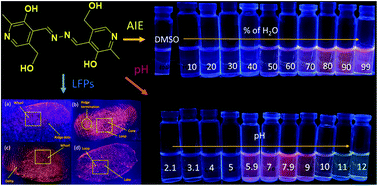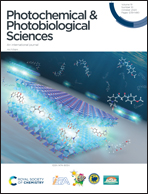An aggregation-induced emission active vitamin B6 cofactor derivative: application in pH sensing and detection of latent fingerprints†
Abstract
Aggregation-induced emission (AIE) properties of an easy-to-prepare and structurally planar Schiff base derivative of the vitamin B6 cofactor pyridoxal (L) were investigated in DMSO–H2O mixed solvents. Compound L showed weak fluorescence (λem = 425 nm) in pure DMSO, but increasing the fraction of water in DMSO resulted in a significant fluorescence enhancement at 575 nm due to the restriction of intramolecular rotation (RIR) of L upon aggregation. SEM analyses revealed the formation of hairy micelle-like or needle-shaped self-assemblies/aggregates of L. The DFT calculations were performed to examine the tendency of L to form self-aggregates, and the results indicate the formation of several intramolecular non-covalent interactions that energetically favored the self-aggregation of L. The pH sensing study revealed that the red-emission of aggregates of L between pH 5.9 and 9.0 turned into green emission at the basic pH with the estimated pKa values of 9.39 and 10.22. Further, the aggregates of L were applied for the visualization of latent fingerprints (LFPs) over a non-porous glass slide.



 Please wait while we load your content...
Please wait while we load your content...